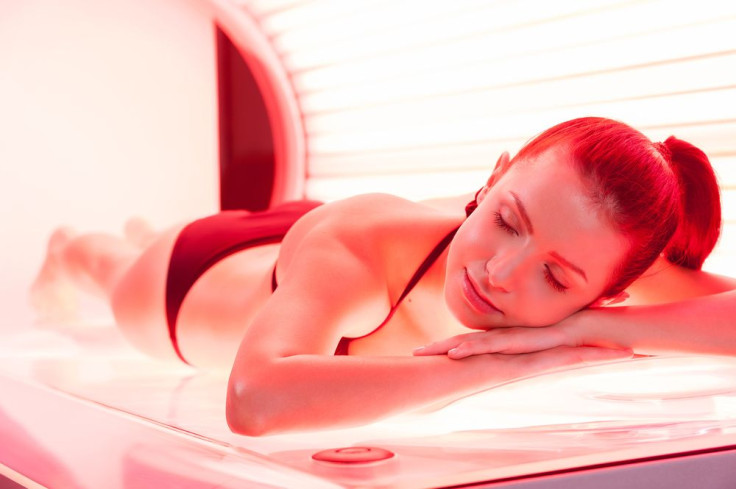Tanning Beds Remain Dangerous: Even If You Don't Get Sunburn, Melanoma Risk Still High

Visiting the tanning salon is a popular activity during the spring, just as people start to prepare their base tan for the summer sun, but the dangers remain in the dark for many oblivious indoor tanners. A new study has found that the base-tan can seem deceivingly harmless because it doesn’t burn, but tanners should be aware of the damage they’re inflicting and the risks they’re raising for themselves.
Researchers from Masonic Cancer Center, Department of Dermatology, and Division of Epidemiology and Community Health, University of Minnesota, Minneapolis, published their findings in the Journal of the National Cancer Institute, which looked at diagnosed melanoma patients from 2004 to 2007, between the ages of 25 to 59 years old and compared them to healthy, cancer-free patients. "Indoor tanning has really high amounts of ultraviolet light that damages the skin and really increases your risk for skin cancer," Dr. Jennifer Stein, an assistant professor in the department of dermatology at NYU Langone Medical Center in New York City, told HealthDay.
Indoor tanning has already been exposed as a dangerous practice because the user is exposed to two types of ultraviolet (UV) rays, UVA and UVB, which damage the skin and can lead to common skin cancers, such as squamous cell carcinoma, basal cell carcinoma, and the most dangerous of all, melanoma, according to the Centers for Disease Control and Prevention. However, with this new study, researchers can now prove that even if you don’t burn yourself while indoor tanning, it doesn’t mean that you haven’t caused bodily harm. Ultimately, indoor tanning is carcinogenic to humans. “Melanoma can be deadly, if not detected early,” Stein said. "Preventing people from using indoor tanning beds is a very important message, particularly for young people."
Researchers took a total of 1,167 melanoma patients with 1,101 control subjects and matched them by age and gender, and asked them questions, such as age, gender, income, education, eye color, skin color, hair color, number of freckles and moles, family history of melanoma, and their tanning practices. After looking at all of the information they collected, researchers concluded that “…indoor tanning, even when used in a way that does not produce burns, is a risk factor for melanoma."
Why is melanoma so dangerous?
Anyone can get melanoma. When found early and treated, the successful treatment rate is nearly 100 percent. If melanoma goes untreated, it will spread to other parts of the body and can spread quickly. Melanoma is usually, but not always, a cancer of the skin. It begins in melanocytes — the cells that produce the pigment melanin that colors the skin, hair, and eyes. Melanocytes also form moles, where melanoma often develops, which is why it’s important to have a dermatologist check new skin growths as early as possible. Having moles can be a risk factor for melanoma, but it’s important to remember that most moles do not become melanoma.
Nearly 65 percent of melanoma cases can be linked to exposure to ultraviolet (UV) rays from natural or artificial sources, such as sunlight and indoor tanning beds, according to the American Academy of Dermatology. However, since melanoma can occur in any melanocytes throughout the body, even those that are never exposed to the sun, UV light cannot be solely responsible for a diagnosis. Current research points to a combination of family history, genetics and environmental factors that may also play a big role in the development of melanoma and skin cancer.
The tanning industry, which made an estimated $2.6 billion in 2010, has tried to tell consumers that vitamin D is necessary and that it should be sought from tanning beds. The fact is that all necessary vitamin D can be found in a healthy diet or from a vitamin supplement. If you are concerned about your vitamin D levels, which can be indicated by lack of nutrient intake or unusual sleepiness, consult your doctor for a proper evaluation and diagnosis instead of treating a tanning salon as a medical tool.
It’s important to keep in mind that the bottom line is there is no such thing as a safe tan. Tanned skin, which is the darkening of pigment, is a result of damage to skin cells. Research is well-supported to suggest that the cumulative damage to skin cells can lead to wrinkles, age spots, premature aging, and skin cancer.
"The bottom-line is that tanning is a biological response to damage to the DNA," DeAnn Lazovich, the study’s co-author, told HealthDay. "And you're going to get that [ultraviolet light] damage in a tanning booth whether or not you burn." Research indicates that just one blistering sunburn can double your chances of developing melanoma later in life. In addition, using tanning beds before age 35 increases your risk of developing melanoma by 75 percent. Occasional use of tanning beds triples your chances.
Source: Lazovich D, Vogel R, Ahmed R, et al. Exposure to Indoor Tanning Without Burning and Melanoma Risk by Sunburn History. Journal of the National Cancer Institute. 2014.



























